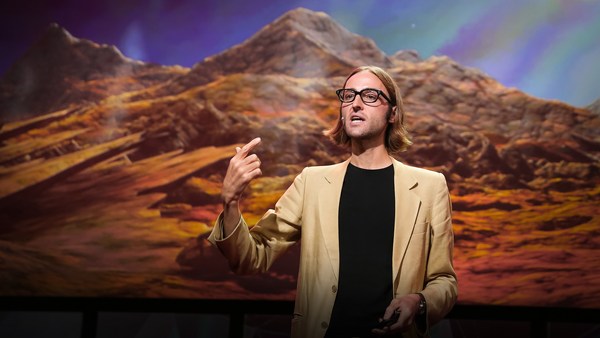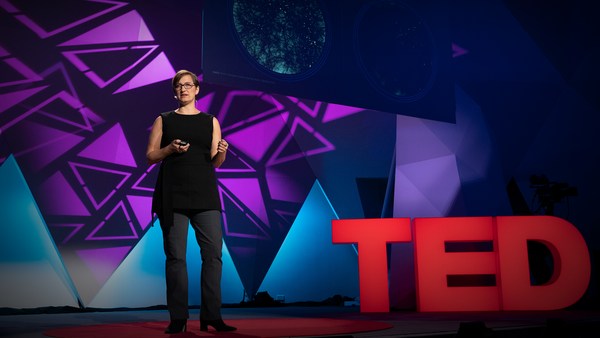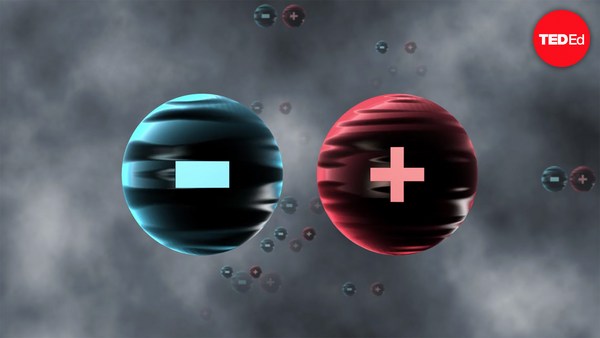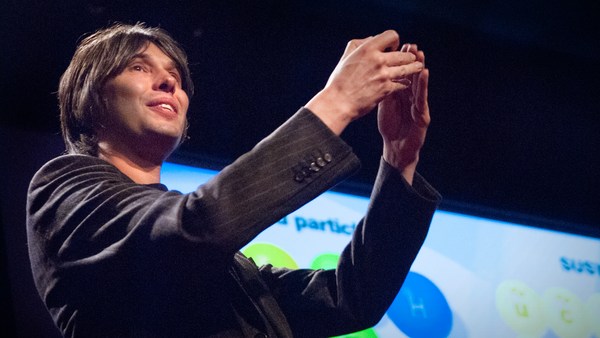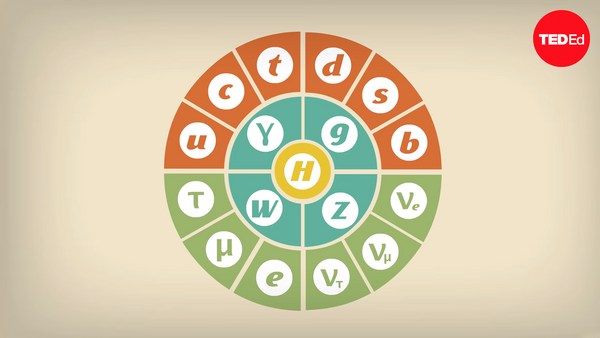Have you ever taken your 3-D glasses off at the cinema? The picture looks blurry and it can be difficult to see exactly what is happening. This is because 3-D glasses trick our brain into forming a 3-D image by controlling the color of the light that each sees using a different filter in each lens. You could say sometimes seeing things from a different perspective can make them look clearer and easier to understand. This is exactly the approach that has helped me with my research, looking to answer some of the most fundamental questions we have about our universe.
To put this in a different context, I could see some people finding my voice difficult to understand due to my cerebral palsy as an insurmountable barrier to giving a TED Talk. Even if I saw that there are alternative ways for people who have difficulties with communication to speak to an audience, I could be put off from using them, thinking that this dry computerized voice has no life in it and would put you all to sleep within five minutes. Alternatively, I could see the dodgy female British synthesized voice as something to be embraced, pepper this talk with jokes and gags, sometimes at the poor communication aid's expense, and hopefully make you laugh and keep you engaged with what I want to tell you about. Luckily for you, I have chosen the second option.
And what do I want to tell you about? I'm here to tell you that we have completely misplaced 96 percent of the entire universe, everything in existence. That's an awful lot of missing socks. I am a particle physicist analyzing data from the Large Hadron Collider at CERN in Switzerland to answer the most fundamental questions about our universe. At school, I was the archetypal geeky kid just wanting to get the other lessons done to get into the science lab. My work now focuses on what I truly believe is one of the greatest achievements of scientific research in the last century. A scientific model that describes the properties and behavior of all the known particles in the universe. And as particle physicists have no imagination, we call it the Standard Model. For me, having one model with so much power is as close as science gets to describing nature at its most basic level.
When I first heard about the Standard Model, it really blew my mind and gave me the passion to focus on my studies in physics. But I also knew that I would have to think about them a little differently to my fellow students. For example, I had to demonstrate in examinations that I had understood the practical techniques that I had been taught. Due to my disability, I don't have enough control of my hands to be able to pick up laboratory equipment and use it. So I had to effectively borrow someone else's hands. I practiced giving extremely detailed instructions to my assistant about how to use the equipment in order to perform the experiment. Seeing experiments from the perspective of a series of instructions that I had to give as clearly as possible really helped me get into the mindset I needed to understand how I could perform well in my practicals, which I did. Recognizing that I was able to look at such issues in a different way, helped me to find the tenacity to persevere with mastering the practical side of my scientific studies rather than letting my physical limitations stop me. Now, my research with the Large Hadron Collider involves me writing a lot of code to analyze the data used to study the standard model. I dictate what I would like my assistants to type, as typing it for myself would be too slow and effortful. It does take a slightly different mindset to speak your work rather than write it, especially when all the education you receive is aimed at people who can quickly scribble things down. However, I have found that telling myself that I am doing basically the same actions as everyone else has helped me to understand how to proceed in pursuing my passion for physics.
Now, you know how I do my research. Let's get back to my favorite model and hopefully yours after this talk, because unfortunately, we have a bit of a major snag. The Standard Model only describes four percent of the universe. To understand why, you have to look at how fast galaxies are spinning. Newton's laws tell us that they would simply fly apart if there wasn't some other kind of massive substance within them to bring them together. This missing mass is called dark matter, and we observe that it accounts for 23 percent of the universe. So what about the rest? Well, the discovery that the expansion of the universe is accelerating rather than decelerating due to gravitational attraction, points to the existence of a force acting against gravity. We call this force dark energy, and it accounts for the remaining 73 percent of the universe. Neither dark matter nor dark energy are included in the Standard Model. So there is a staggering 96 percent of the universe that we know absolutely nothing about. Therefore, it turns out that my favorite model, that I thought could describe every particle in the universe, isn't as all encompassing as I initially thought. So is there a way to look at the particles that are already described by the Standard Model differently in order to discover these absent particles?
You might think that we would be racking our brains to design detectors that could produce some kind of photograph of these elusive particles to prove that they are there. Surely if you want to find something that's missing, that's the general approach you have to take, right? Wrong. We actually just have to accept the fact that these missing particles are not going to interact with our detectors, whatever we do. But that's not game over. In the same way that I didn't give up on being able to do laboratory experiments myself, but instead used someone else's hands, we use the particles that we can detect to spy on the particles that we think are there but hiding. At the Large Hadron Collider, we accelerate particles to speeds very close to the speed of light such that they smash into each other and release enormous amounts of energy. We use protons that are found in the atoms that comprise all the matter that we see around us, including you and me. However, it is when these protons collide head on that the really interesting physics happens. Such colossal amounts of energy are released that particles that are fundamentally different from the protons that we began with are created. It's a bit like if you smashed two apples against each other, expecting them to turn into something completely different, like a pile of cherries. Using extremely sophisticated detectors, we are able to tell what kinds of particles have been made, but only the types we already know about.
So how are we going to find these other mysterious particles? Fortunately, a fundamental law of nature comes to our rescue and allows us to study these particle collisions from a different perspective. Energy can neither be created nor destroyed, only transferred. If you add up the energy of the particles before and after the collision, you would find that they are equal. We know the energy of the protons entering the collision and we make very sensitive measurements of the energy of the particles that come out. If those two energies are not identical, alarm bells start to ring. Perhaps one of the principles that underpin our understanding of nature, conservation of energy, is incorrect. Or as everyone is hoping, the missing energy could have been stolen by particles that elude our detectors and could help us answer some of the most fundamental questions we have in physics today.
Now, I know what you are going to ask me. Have you found the missing particles yet? Sadly, we haven't. Some people might see this as a reason to lose hope that we are ever going to fully understand the basic building blocks of the cosmos. However, I believe that this is perhaps the most exciting time to be conducting fundamental physics as we have so much left to discover. But aside from thinking about some of the most exciting questions in science, I find that being open to seeing a situation from a different perspective is most meaningful when applied on a personal scale. It encourages you to seek out the positive in each person and situation, no matter how difficult, and use it to bring out not only our own potential, but that of those around us. I feel this is something we could all benefit from at the moment. It doesn't always mean that you will find what you're looking for right away or that it will be easy. But for me, this mindset helped me get where I am today, and it keeps me going. Looking at the world around us today, we are surrounded by big questions without obvious answers. Perhaps by embracing a new way of thinking, by being truly open to other people who don't share our perspective, we might just be able to discover new solutions to the problems we are all facing. Thank you.
